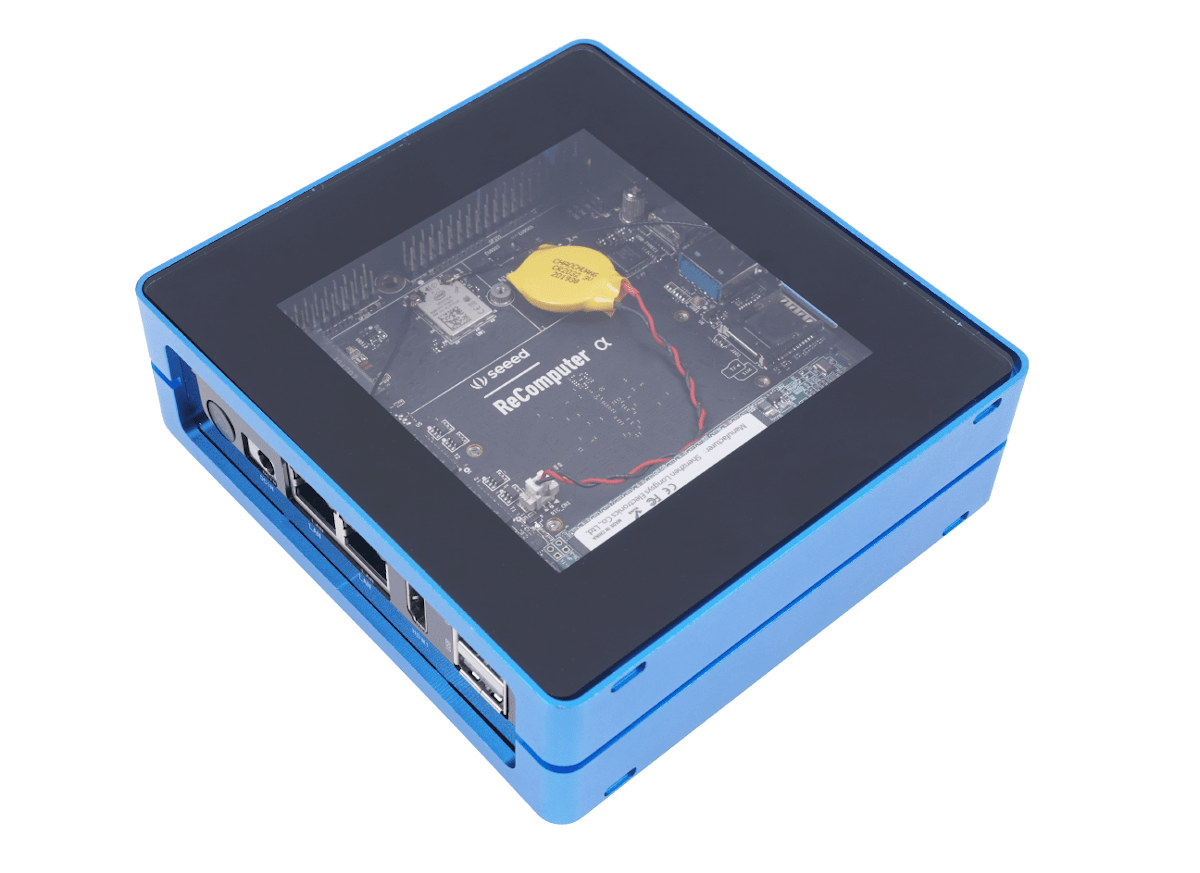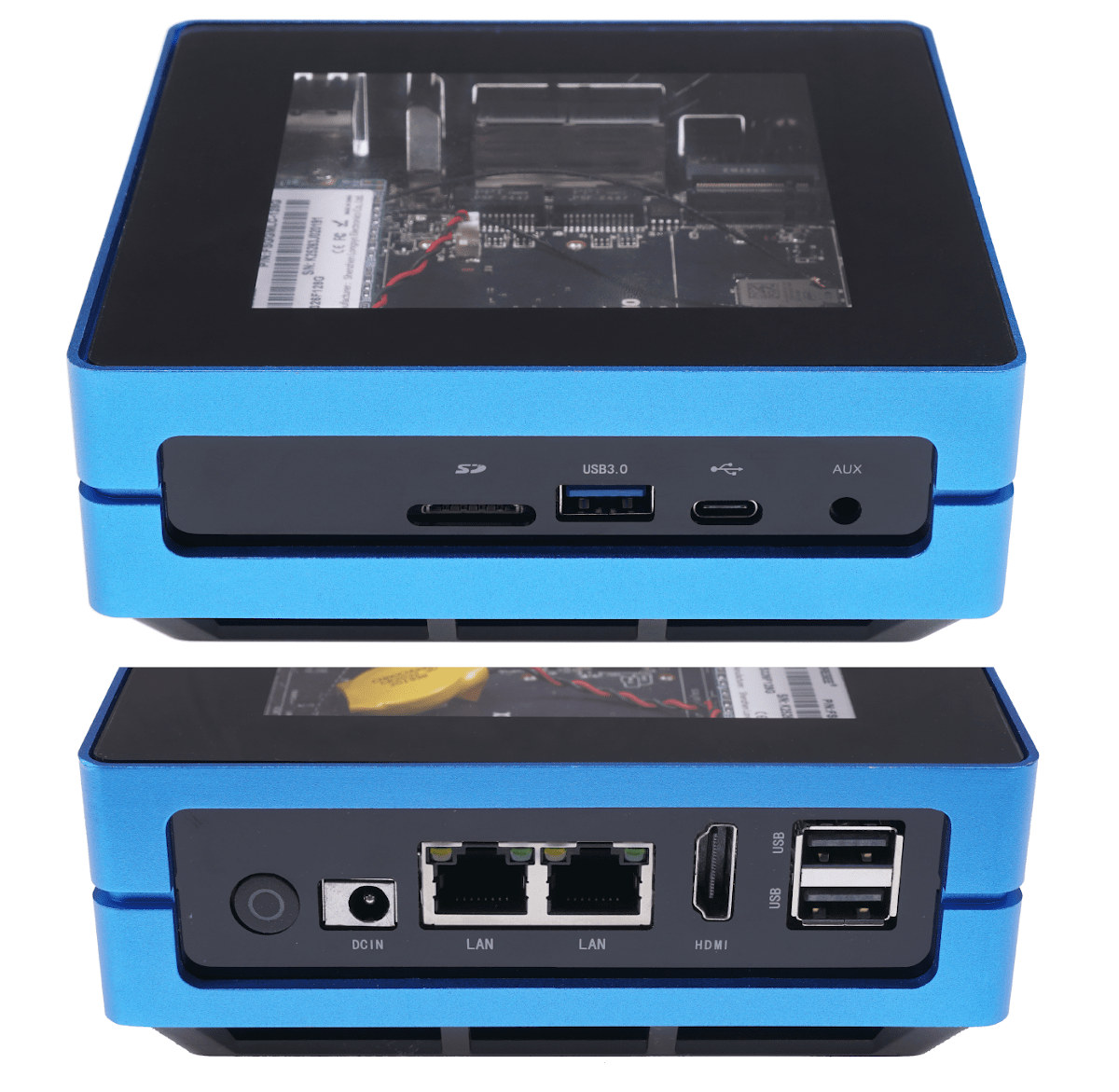We recently reviewed ODYSSEY-X86J4105 SBC by Seeed Studio with Windows 10, and installed it to the Re_Computer case to convert it into a mini PC. Besides being a standard Intel Gemini Lake SBC, the board also comes with an Arduino MCU and header, as well as a 40-pin I/O header so it can be an all-in-one Arduino development platform, or be used for advanced robotics projects.
Both the board and case had to be purchased separately, and Windows 10 was pre-installed on the internal eMMC flash. But now, Seeed Studio has started to offer Odyssey Blue J4105 mini PC with ODYSSEY-X86J4105 SBC pre-installed into Re_Computer case and fitted with a 128GB SSD for increased storage capacity and better performance.
 Odyssey Blue J4105 mini PC specifications:
Odyssey Blue J4105 mini PC specifications:
- SoC – Intel Celeron J4105 quad-core processor @ 1.5/2.5 GHz (Turbo) with 12EU Intel UHD Graphics 600 @ 250-750 MHz; 10W TDP
- System Memory – 8GB LPDDR4 RAM
- Storage
- 128GB M.2 SATA SSD
- Support for M.2 NVMe SSD
- 1x SATA III data connector & 3x SATA power headers
- Micro SD card socket
- Coprocessor – Microchip ATSAMD21G18 32-bit Arm Cortex M0+ MCU
- Video Output
- HDMI 2.0a up to 4K (4096×2160) @ 60 Hz
- DisplayPort 1.2 up to 4K (4096×2160) @ 60 Hz
- Audio – HDMI; 3.5mm microphone + headphone combo jack; front panel audio connector
- Connectivity
- Dual Gigabit Ethernet (RJ45) via Intel I211AT PCIe Gigabit controller; Wake-on-LAN and PXE support
- Dual-band Wi-Fi 5 802.11 a/b/g/n/ac GHz HT160 & Bluetooth 5.0
- Optional 3G/4G cellular connectivity via M.2 card and onboard SIM card socket
- USB – 2x USB 2.0 Type-A ports, 1x USB 3.1 Type-A port, 1x USB 3.1 Type-C port
- Expansion
- 40-Pin header compatible with Raspberry Pi
- 28-pin header connected to SAMD21G18
- M.2 Key B 2242/2280 socket with SATA III, USB2.0, UIM
- M.2 Key M, 2242/2280 socket with PCIe 2.0 ×4;
- Security – Built-in TPM 2.0 chip
- Debugging – 4-pin UART header for SAMD21G18
- Misc – Power button, RTC battery
- Power Supply
- 12-19V via DC Jack 5.5/2.1mm
- 5-12V via USB-C port (USB PD support)
- Dimensions – 12.9 x 12 x 5 cm
- Weight – Around 490 grams
- Certifications – FCC, CE
The mini PC ships Windows 10 Enterprise with an unactivated license. That’s great if you plan to use a Linux distribution, but less so if you’d like to run Windows, as you may need to obtain a more expensive license. You’ll find resources to get started on the Wiki.
Some of the use cases include OpenWrt projects and pfSense making use of the dual Gigabit Ethernet, NAS (Network-Attached Storage), high-performance virtual router, 4G LTE Gateway, and robotics thanks to the Microchip SAMD21 Cortex-M0+ microcontroller, and I/O headers. Note the Arduino header works on both Windows and Linux, but the 40-pin “Raspberry Pi” header is only accessible from Linux. I haven’t tried Linux yet, but the ODYSSEY-X86J4105 Ubuntu 20.04 review should be out by the end of the month.
Odyssey Blue X86J4105 mini PC is sold on Seeed Studio for $239 plus shipping.

Jean-Luc started CNX Software in 2010 as a part-time endeavor, before quitting his job as a software engineering manager, and starting to write daily news, and reviews full time later in 2011.
Support CNX Software! Donate via cryptocurrencies, become a Patron on Patreon, or purchase goods on Amazon or Aliexpress






Salut,
It could be very interesting !
One of the major drawback of such solution is the need to communicate with arduino with serial connection. I think that there is a lot of sensors that can use on Linux with the Raspberry pi port when premptive measure are not needed. Do you know if there is hardware SPI et I2C ?
Are there libriraries to play with ?
It would be very interesting to port adafruit blinka on such device ! It will give the best of the two worlds !
Il you could test the Linux pin acess it would be very helpful. If it works I’m sure to buy it for work !
The Linux review should be up in about two weeks. I’ll test both Arduino and Raspberry Pi headers.
Looking at the images, initially the choice os 2 x USB 2.0 ports looked like a backward step but with the USB-C with PD, an external dock would solve that problem.
The price is pretty good for the specs too, so looks pretty positive.
* Obvious Comparison – Full ASRock J4105-Based PC Build vs. Seeed Odyssey (TL;DR: ASRock Wins – IMO):
1. ASRock J4105 Celeron Motherboard MiniITX & CPU Combo, B079GHR8L9, qty.-1, $75.99
2. Crucial 8GB Kit (4GBx2) DDR4 2400 MT/s (PC4-19200) SR x8 DIMM 288, B019FRCY2U, qty.-1, $37.95
3. Kingston 120GB A400 SATA 3 2.5″ Internal SSD SA400S37/120G, B01N6JQS8C, qty.-1, $24.99
4. APEVIA SFX-AP400W Mini ITX Solution / Micro ATX / SFX 400W P.S., B01MEDG1PM, qty.-1, $29.99
5. Cooler Master MasterBox Q300L Micro-ATX Tower, B0785GRMPG, qty.-1, $49.99
6. Total Cost $218.91 USD
Notes:
1. Compare: Seeed Odyssey J4105 Celeron, no Windows 10, 128GB eMMC, re_computer case… $239 + shipping from China.
2. All ASRock J4105 parts prices are from Amazon.com on 07-August-2020, ASIN codes are shown, free shipping included, shipping times were 4-days or less in CONUS.
3. The ASRock J4105 Celeron Motherboard can easily accept a SATA expansion card for a NAS build, the Odyssey cannot.
4. With the PC build if you need GPIO, I2C, SPI, serial, etc., you can plug a micro-controller into it, any micro-controller you like. Also, the ASRock motherboard has 2 x RS-232, and 1 x LPT headers on it.